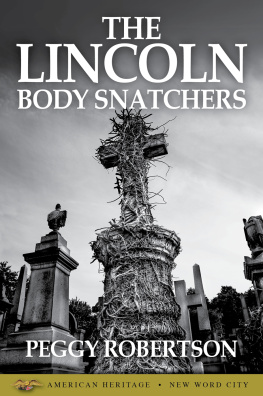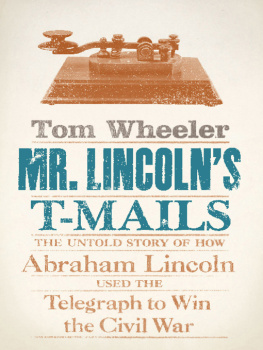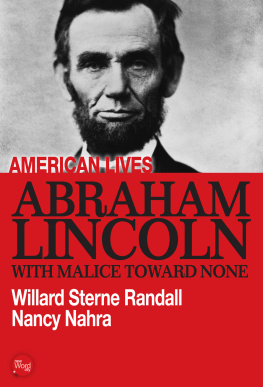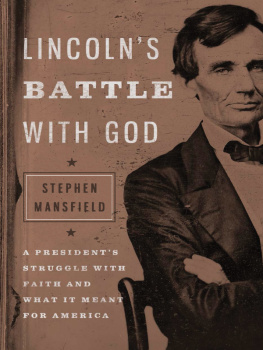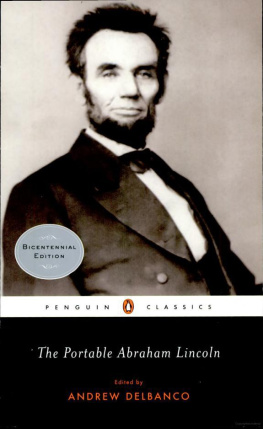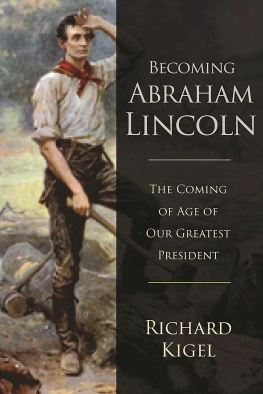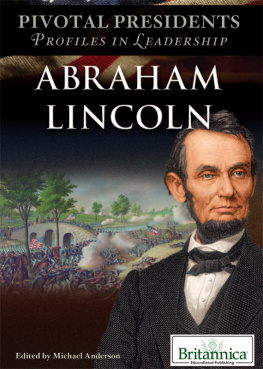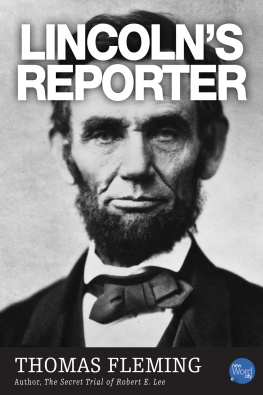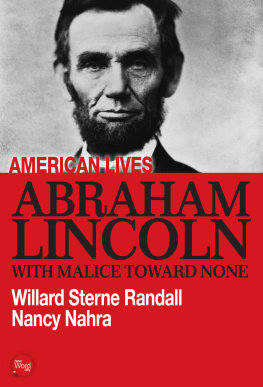Peggy Robertson - The Lincoln Body Snatchers
Here you can read online Peggy Robertson - The Lincoln Body Snatchers full text of the book (entire story) in english for free. Download pdf and epub, get meaning, cover and reviews about this ebook. year: 2014, publisher: New Word City, genre: Detective and thriller. Description of the work, (preface) as well as reviews are available. Best literature library LitArk.com created for fans of good reading and offers a wide selection of genres:
Romance novel
Science fiction
Adventure
Detective
Science
History
Home and family
Prose
Art
Politics
Computer
Non-fiction
Religion
Business
Children
Humor
Choose a favorite category and find really read worthwhile books. Enjoy immersion in the world of imagination, feel the emotions of the characters or learn something new for yourself, make an fascinating discovery.
- Book:The Lincoln Body Snatchers
- Author:
- Publisher:New Word City
- Genre:
- Year:2014
- Rating:4 / 5
- Favourites:Add to favourites
- Your mark:
- 80
- 1
- 2
- 3
- 4
- 5
The Lincoln Body Snatchers: summary, description and annotation
We offer to read an annotation, description, summary or preface (depends on what the author of the book "The Lincoln Body Snatchers" wrote himself). If you haven't found the necessary information about the book — write in the comments, we will try to find it.
Counterfeiting was big business in the 1860s. So was snatching bodies. Here, in the short-form book, is the story of the men who plotted to steal Abraham Lincolns body as a way to bribe the government to free the countrys finest engravers of counterfeit money.
The Lincoln Body Snatchers — read online for free the complete book (whole text) full work
Below is the text of the book, divided by pages. System saving the place of the last page read, allows you to conveniently read the book "The Lincoln Body Snatchers" online for free, without having to search again every time where you left off. Put a bookmark, and you can go to the page where you finished reading at any time.
Font size:
Interval:
Bookmark:
Jack Hughes was a talented passer of phony bills. An honest-looking man, respectably bearded and always well dressed, he spent his working days going from store to store, making one small purchase after another, and paying for it with crisply persuasive counterfeit money.
If his currency ever was questioned and the police called, no case could be made; he never had more than one bad bill in his possession.
Hughes working supply trailed along a full block behind him, in the form of a small boy whose pockets were stuffed with bogus cash. After each stop, the youngster would sidle up and slip Hughes another bill.
But sometime in September 1874, in Washington Heights, Illinois, something went wrong. Hughes was arrested by Secret Service agents and indicted for passing five counterfeit bills. He had jumped bail and was being sought by every policeman in Chicago.
Counterfeiting entrepreneur James Kinealy, also known as Big Jim Kinelly (spellings of his last name varied), a sometime St. Louis livery-stable operator whom a local reporter once characterized as a born crook, devised a bizarre scheme that would later involve Hughes.
Kinelly had served a five-year term in the Illinois State Penitentiary for passing a bogus $50 note in Peoria; thereafter, he kept his own hands clean of counterfeit bills. Instead, he became a wholesaler, linking the actual producers of the fake bills with independent gangs of counterfeit pushers in Illinois. Counterfeiting had long been an important cottage industry . In 1865, when the Secret Service was organized to restore public confidence in the money, fully half the bills circulating were believed to be phony.
Ben Boyd, regarded by crooks and cops alike as the one of the finest of engravers, was a prime source of unauthorized money. One of his $5 plates was so perfect that it was used to print over 300,000 bills and passed without mishap by one gang alone. And the Treasury of the United States finally paid Boyd its ultimate tribute: It recalled its genuine fives from circulation.
In 1875, though, Ben Boyd was arrested, and his subsequent sentencing to ten years in the Illinois State Penitentiary left Big Jim Kinelly and his network of printers, wholesalers, and passers virtually jobless. The prime Midwestern wholesaler of all those perfect counterfeit bills now had nothing to sell.
Ben Boyd had to be sprung. As a contemporary lawman saw it: They knew that money could not get him out. It had all been talked up, the money could have been gotten, but it was impossible. So what to do? Kinelly thought he had the perfect solution: He (or rather his hirelings) would steal the corpse of President Abraham Lincoln . Then they would offer to exchange it for the freedom of Ben Boyd - plus a big cash bonus.
It is not surprising that Kinelly should have hit upon body snatching. It was endemic in rural America, with grave robbers digging up recently interred bodies for surreptitious sale to medical schools. The bereaved frequently stood guard at the graveside for weeks after the burial.
In fact, Kinelly was not the first man to plot to steal Lincolns corpse. Only months after the presidents body was returned to Springfield in 1865, an Illinois lawyer (his name now forgotten) apparently had tried to round up accomplices for such a scheme. But he found no takers and forgot about it.
Kinelly got off to a bad start with his plotting. Early in 1876, he assembled one of his counterfeit-passing rings at the disreputable tavern of Ben Sheridan, Kinellys agent in nearby Lincoln, Illinois. He told gang members that he wanted them to take Lincolns body from the tomb, hide it in a brick beer cave south of the cemetery, and hold it until ransom was paid and Boyd was released from prison.
Kinelly dispatched Ben Sheridan and four of his passers to Springfield, where at his own expense they fitted up a saloon in a rented downtown store. Sheridan was the bartender and ostensible owner; his four charter customers spent much of their time leaning against the bar. They planned to move on the night of July 3, but then, with just two weeks to go, Sheridan later described by the Lincoln Memorials custodian as a man of more intelligence than either [sic] of the other four, or all of them combined, but of exceedingly depraved morals - succumbed to temptation. Touring Springfields brothels, he confided to one of his hostesses that his little band was going to steal old Lincolns bones, collect a ransom, and spend the proceeds in the ladys establishment. The hostess was more morally upright and told the sheriff of Sheridans plans. The next morning, through a monumental hangover, Sheridan learned of his indiscretion. Kinelly then washed his hands of the gang. Ben Sheridan, professionally disgraced, went back to being a local nuisance.
Kinelly was determined to try again, and later that same summer, he began commuting between St. Louis and Chicago, where he presided over discussions in the back room of his Chicago branch office, a bar at 294 West Madison Street called The Hub. Dank , dusty, and sleazy, it differed from a thousand other saloons in only two respects: its bust of Abraham Lincoln above the bar and its club room for counterfeiters. Its bartender and nominal owner was twenty-seven-year-old Terrence Mullen, and one of his steadiest customers was the counterfeit passer Jack Hughes, now out on bail.
Here, in the autumn of 1876, Mullen, Hughes, and Kinelly developed their new plot: They would meet in Springfield, steal Lincolns body, load it onto a wagon, and, using relays of horses, speed it some 200 miles to the sand dunes bordering the southern tip of Lake Michigan, just southeast of Chicago. There they would bury the body, carefully triangulating the site against permanent landmarks so they could find it again in the ever-shifting sands, and then wait for the government to meet their demands.
Behind them, inside the tomb, they would leave a piece torn from the front page of The Catholic Union and Times , published in England and purchased at Tom Mackins newsstand on Dearborn Street. This newspaper was so rare in Chicago that the police would surely recognize it as a clue. The rest of the front page would be hidden inside the bust of Lincoln above the bar at The Hub. It would be used to identify Kinelly and Company as the genuine kidnappers when the time came to announce their demands: $200,000 in cash and the release of Ben Boyd. Kinelly and Hughes were quite willing to settle for Boyd and the cash, but Mullen seemed almost obsessed with the notion that the body snatching would win the criminals the respect of the American people into the bargain.
Early in October, the agent in charge of the Indianapolis Secret-Service office was tipped off by a young criminal for whom he had done a favor three years before. He immediately informed the Chicago bureau chief, Patrick D. Tyrrell.
Tyrrell at once recruited Louis C. Swegles to infiltrate the gang, and it is to him - and to the night police reporter for the ChicagoTribune to whom he eventually told all he knew - that we owe our knowledge of the plot. Contemporary accounts vary, but Swegles apparently had been a seaman and then probably a petty crook. By 1876, however, he was well launched on a career as a professional informer, or roper , for the Secret Service.
Swegles started spending time at The Hub. I got myself up in their minds, he recalled later, not by praising myself but my friends - Frenchy the burglar, Bill Wray, and others. I had a letter from Frenchy, who is in Michigan City Penitentiary. They thought I was a first-class man or I would not be known to such men.
Swegles reported daily to Tyrrell, who passed on the information to the chief of the Secret Service. (Though someone at the U.S. National Records Center years ago saw fit to destroy the entire Secret Service file on the plot, a clerk fortunately had typed and preserved in 1938 a six-page resume of Tyrrells reports to his boss on the case, including some verbatim extracts.)
Next pageFont size:
Interval:
Bookmark:
Similar books «The Lincoln Body Snatchers»
Look at similar books to The Lincoln Body Snatchers. We have selected literature similar in name and meaning in the hope of providing readers with more options to find new, interesting, not yet read works.
Discussion, reviews of the book The Lincoln Body Snatchers and just readers' own opinions. Leave your comments, write what you think about the work, its meaning or the main characters. Specify what exactly you liked and what you didn't like, and why you think so.

